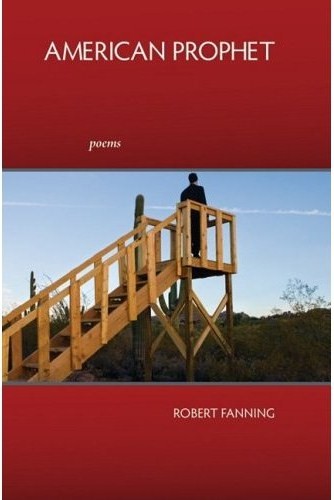Issue 3 - Spring 2010 Reviews American Fractal American Prophet Contents of a Mermaid's Purse Easy Marks Entrepôt Flinch of Song I Have to Go Back to 1994 and Kill a Girl In the Voice of a Minor Saint Sarah J. Sloat No Boundaries: Prose Poems by 24 American Poets Noose and Hook Please Self-Portrait with Crayon Some Weather The Best Canadian Poetry The Ravenous Audience Underlife Voices Interviews
 |
Robert Fanning’s Prophet is everywhere, watching us, observing us, viewing us in all of our clumsy, indelicate moments, in all of our foibles, faux pas, obsessions and passions, all the while making pronouncements that no-one hears, much less pays heed to. Yet, despite his ineffectuality, the Prophet is endearing—a persona unlike any other in poetry today. So compelling, in fact, that it is never quite clear whether Fanning’s third collection, American Prophet is the poet’s glorious creation or the Prophet’s poetic manifesto. It would be nearly impossible to discuss American Prophet, the book, without spending an inordinate amount of time reflecting on the Prophet. The Prophet appears in all 36 of the collection’s poems; this collection is his collection. Let there be no mistake, however, without Fanning as the puppet (poet) master, putting his character into situation after situation, setting after unique setting with skill and aplomb, there would be no record of the Prophet’s remarkable journey. Each poem in this collection is a narrative masterpiece, the details so clear and sharp they read like mini screenplays. Fanning’s sharp eye for detail and ear for best words sets a visually stunning scene time after time. In “The Prophet at the Barn Looking for the Face of God,” you have but to read the opening:
and you, too, are trudging with the Prophet “through calf-high/ tornados of dust and skittering tumbleweed. As the last light like a seed drops/ into August earth…” Shift to another scene, the poem “The Prophet in Flight,” and you are transported to “an eastward red-eye flight across/ the country,” witnessing alongside the Prophet:
Only a poet intent on painting the most vivid picture imaginable could create such musical imagery as “through shredded sails/ of cirrus.” Repeat that line aloud and watch those thin, wispy clouds drift before your eyes. Just as his protagonist is multi-faceted, so Fanning is a poet of many talents, achieving that rare blend of storyteller, cultural observer and master of language, all the while wryly admonishing us for watching bad apocalyptic movies and, like the townspeople in “The Prophet and the Symphony of Broken Horns,” tuning in to “lite ballads/ and one hit wonders,” blindly bopping to radio pop. Ironically (or is it?), Fanning chooses to display some of his most artistic talent among the big-box store aisles in “The Prophet at the Superstore.” Who but a comic genius calls Wal-Mart or any of its brethren superstores a “fluorescent cathedral, ” or yokes together the disparate images of house of worship aisles into a poem where “the Prophet’s lost/ in the walled maze of aisles” and later, ominously, “the aisles begin/ to darken.”? Who among us, after stepping foot into one of the great marts, has not felt deep in our hearts as the Prophet does, “there’s a war.”? It may be just a “laser-guided fireworks display,” but in Fanning’s skilled hands, we are shown a frightening display of what our lives are really like. For those of you who did not stop to read the poem titles before embarking on the Prophet’s pilgrimage across these United States of pop culture, it becomes a sort of game, guessing where our intrepid guide will show up next—a pseudo-biblical Where’s Waldo, including visits to an Elvis impersonator concert, the dry cleaners, a casino, a barn purported to hold the face of Jesus in its beams, a superstore, a traffic jam, a war zone and, of course, a poetry reading. After all, a prophet’s role is to effect social change through traveling with his divine message. What better way to reach 21st century humanity than a journey to the local Wal-Mart? To be sure, a prophet is a religious persona, by definition one who utters divinely inspired revelations. Yet, Fanning is never heavy-handed in his portrayal of the Prophet. Instead, he keeps a biblical theme alive by masterfully infusing his poetry with imagery and language that serves a dual purpose. To begin, we see “The Prophet at the Dry Cleaners,” where an old woman “from another world” predicts, by way of describing his torn suit, the Prophet’s eventual failings:
Fanning is as much of a storyteller as he is a poet, creating a host of characters, common, “everymen” and “everywomen” who upstage the Prophet at every turn. It is a testament to his character that the Prophet struggles on in his quest to be heard, while so many other, lesser characters succeed. The superstore announcer, the traffic helicopter pilot in “The Prophet and the Jaws of Heaven,” telling the people “what they already know:/ that they’re stuck. That every way home is slow.” More often than not, like his huge black kite in “The Prophet at the Festival of Kites,” the Prophet “seems less than a passing shadow” to his people. In most instances, he is a character defeated:
Still, we root for the Prophet. We move on to the next poem, the next location, hoping this will be the time the Prophet speaks and his people listen. Unwittingly, we have become “his people,” as intrepid as the Prophet who, instead of giving up, instead “turns, making his way back home, knowing this world’s the one where the work needs to be done.” Reviewed by Jill Crammond Wickham. |
